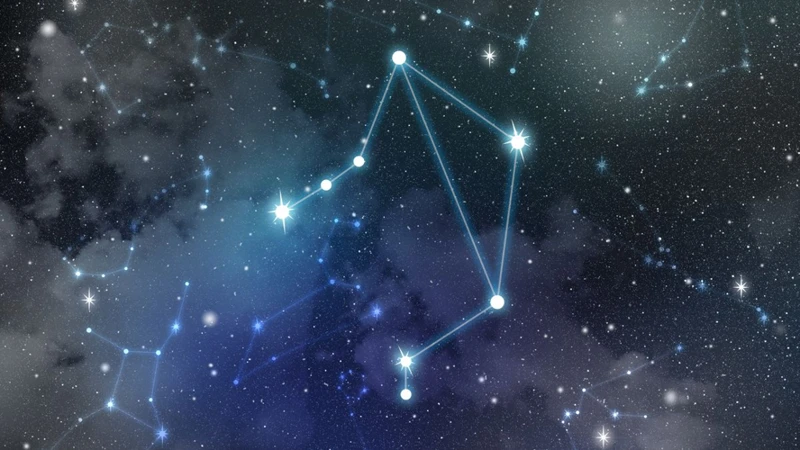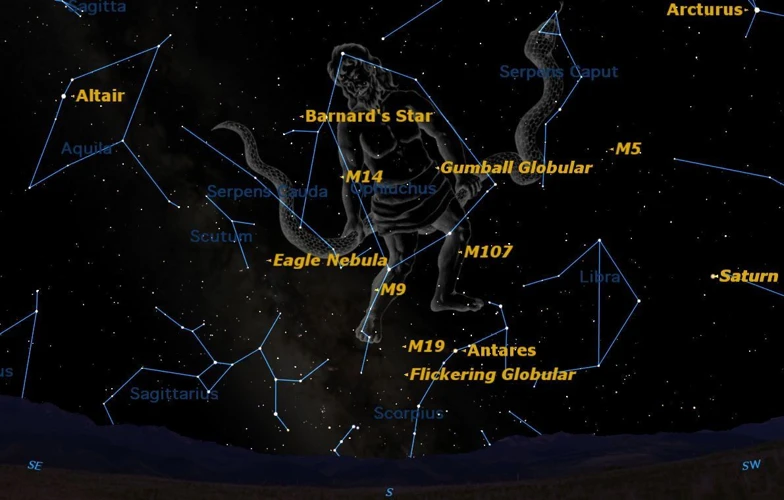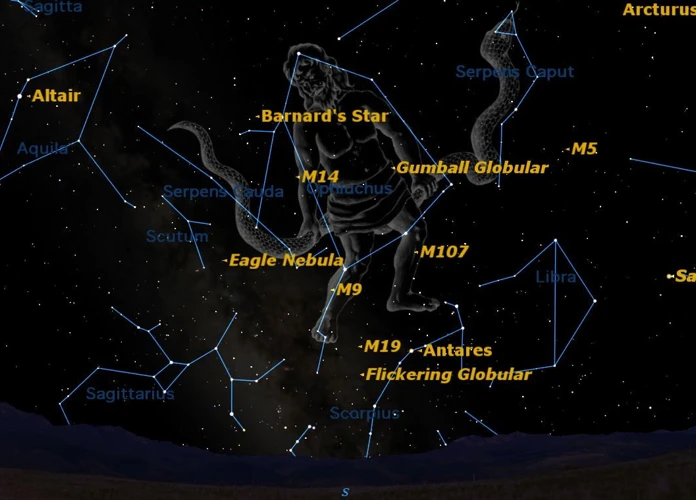Welcome to the fascinating world of Ophiuchus, a constellation that often goes unnoticed but holds a wealth of celestial wonders. In this article, we will embark on an exploration of Ophiuchus, delving into its mythology, the stars that adorn its skies, the captivating deep-sky objects nestled within its boundaries, and even its connection to astrology. Prepare to be captivated as we uncover the hidden treasures of this enigmatic constellation and unravel the controversy surrounding its status as the 13th Zodiac sign. Get ready to embark on a celestial journey like no other.
Contents
- A Brief Overview of Ophiuchus
- Stars in Ophiuchus
- Deep-Sky Objects in Ophiuchus
- Ophiuchus and Astrology
- Conclusion
-
Frequently Asked Questions
- What is Ophiuchus known for?
- How did Ophiuchus get its name?
- Is Ophiuchus part of the zodiac?
- What is the significance of Ophiuchus in astrology?
- Are there any famous stars in Ophiuchus?
- What are some deep-sky objects found in Ophiuchus?
- Can Ophiuchus be seen with the naked eye?
- How can I locate Ophiuchus in the night sky?
- What is the mythology behind Ophiuchus?
- Is Ophiuchus visible from the Southern Hemisphere as well?
- References
-
Frequently Asked Questions
- What is the significance of Ophiuchus in astrology?
- How can I locate the constellation of Ophiuchus in the night sky?
- What is the mythology behind the constellation of Ophiuchus?
- What are some notable stars in the constellation of Ophiuchus?
- What is the Snake Nebula, and where can it be found in Ophiuchus?
- What is the significance of Ophiuchus as the 13th zodiac sign?
- What are the personality traits and characteristics associated with Ophiuchus?
- What is Barnard’s Star, and why is it significant in Ophiuchus?
- What is the significance of Ophiuchus in deep-sky observation?
- How can exploring Ophiuchus enhance my understanding of the night sky?
- References
- Read More
A Brief Overview of Ophiuchus

Ophiuchus, also known as the “Serpent Bearer,” is a constellation located near the celestial equator. It lies between Aquila and Hercules, and its shape resembles that of a man grasping a serpent. Ophiuchus is one of the largest constellations in the sky, spanning an area of approximately 948 square degrees. Despite its size, it often goes unnoticed due to its proximity to the more popular constellations of the zodiac. However, its significance in ancient mythology and its celestial treasures make it a worthwhile object of exploration. Ophiuchus is rich in both stars and deep-sky objects, making it a favorite among stargazers and astronomers alike. Let us embark on a journey through the mythical tales, starry inhabitants, and mesmerizing deep-sky objects of this captivating constellation.
The Mythology behind Ophiuchus
The mythology behind Ophiuchus is steeped in ancient Greek legends. According to one tale, Ophiuchus represents Asclepius, the ancient Greek god of medicine and healing. Asclepius was the son of Apollo, the god of healing and light. The serpent, which Ophiuchus is depicted holding, is a symbol of wisdom and healing in Greek mythology. Legend has it that Asclepius possessed incredible healing abilities and could bring the dead back to life. This power alarmed Zeus, the king of the gods, who feared that mortals would become immortal. In order to maintain balance between the mortal and immortal realms, Zeus struck Asclepius with a thunderbolt, killing him. As a tribute to his greatness, Zeus placed him among the stars as a constellation, immortalizing his healing abilities. The constellation Ophiuchus serves as a reminder of the ancient Greek belief in the power of healing and the importance of balance in the natural world. It is a celestial tribute to the divine art of medicine and the eternal quest for wellness.
The Location and Visibility of Ophiuchus
The constellation Ophiuchus can be found in the southern sky, positioned between the constellations of Aquila and Hercules. Its celestial coordinates are approximately 17 hours right ascension and -10 degrees declination. Due to its location in the celestial equator, Ophiuchus is visible from most parts of the world, particularly in the summer months of the Northern Hemisphere and in the winter months of the Southern Hemisphere. To locate Ophiuchus in the night sky, it is useful to identify the neighboring constellations of Scorpius and Sagittarius, as Ophiuchus lies just above them. With its prominent position and captivating shape, Ophiuchus offers stargazers and amateur astronomers a celestial spectacle worth exploring. So, grab your telescope or binoculars and venture into the realm of Ophiuchus to discover its celestial wonders and unlock the secrets of the stars.
Stars in Ophiuchus

Stars in Ophiuchus add to the constellation’s allure, with some notable ones capturing our attention. One such star is Alpha Ophiuchi, also known as Rasalhague. It is a binary star system consisting of a hot, white main-sequence star and a cooler, dimmer companion. Another prominent star is Beta Ophiuchi, called Celbalrai. This star shines brightly, making it easily visible. It belongs to the spectral class K2III, indicating that it is an orange giant star nearing the end of its life cycle. Additionally, Epsilon Ophiuchi stands out as a young, blue-white star located approximately 109 light-years away from Earth. Its brightness and proximity make it a favorite target for stargazers. These remarkable stars in Ophiuchus’s cosmic realm contribute to the constellation’s enchanting aesthetics and provide astronomers with intriguing subjects of study.
Alpha Ophiuchi (Rasalhague)
Alpha Ophiuchi, also known as Rasalhague, is a prominent star in the constellation of Ophiuchus. It holds significant astronomical and astrological importance. Rasalhague is classified as a binary star system, consisting of a yellow-white main sequence star and a fainter companion. The primary star shines with a magnitude of 2.07, making it one of the brightest stars in Ophiuchus and visible to the naked eye. Its name, Rasalhague, is derived from the Arabic phrase “Ras al-Ḥawwa”, meaning “the Head of the Serpent Charmer”. Rasalhague is approximately 48 light-years away from Earth and has a surface temperature of around 8,500 Kelvin, making it hotter than our own Sun. In astrology, Rasalhague falls under the influence of Ophiuchus, associated with the element of water. Astrologically speaking, this celestial giant is believed to bring transformative energy and represents healing abilities, making it an intriguing point of study for those delving into the metaphysical realm. The influence of Rasalhague is known to complement astrological houses focused on self-discovery and introspection, providing individuals with the potential for deep emotional exploration. As we delve deeper into the wonders of Ophiuchus, it becomes evident that astrology and astronomy beautifully intertwine, offering new perspectives on our existence and the cosmos at large.
Beta Ophiuchi (Celbalrai)
Beta Ophiuchi, also known as Celbalrai, is an intriguing star within the constellation of Ophiuchus. It is a blue-white giant star located approximately 82 light-years away from Earth. Celbalrai shines with a luminosity over 700 times that of our Sun and has a temperature of around 17,000 degrees Celsius. With a magnitude of 2.7, it is one of the brighter stars in Ophiuchus and can be easily spotted in the night sky. Its name, Celbalrai, comes from an Arabic phrase meaning “the shepherd’s dog.” Despite its distance, Celbalrai’s brightness allows us to appreciate its celestial presence and admire its beauty. This mesmerizing star beckons us to gaze into the vastness of space and contemplate our place within the universe. To learn more about how celestial bodies like Celbalrai connect with astrology and influence relationships, you can explore concepts like fire and water astro-compatibility.
Epsilon Ophiuchi
Epsilon Ophiuchi, also known as Yed Prior, is a notable star within the constellation of Ophiuchus. It is categorized as a binary star system, consisting of two stars orbiting around a common center of mass. The primary component, Epsilon Ophiuchi A, is a yellow-white giant star with a magnitude of 2.43. Its companion, Epsilon Ophiuchi B, is a blue-white star with a magnitude of 4.91. Together, they create a striking visual contrast in the night sky. Epsilon Ophiuchi is located approximately 108 light-years away from Earth, and its name, “Yed Prior,” derives from Arabic, meaning “the hand of the serpent’s head.” This name is fitting, as it is positioned near the head of the serpent represented by the constellation’s shape. Epsilon Ophiuchi is a captivating sight to behold for stargazers and serves as a prominent point of interest within Ophiuchus. Its beauty and significance in the constellation further enhance the allure of this celestial wonder.
Deep-Sky Objects in Ophiuchus

Deep within the constellation of Ophiuchus lie a plethora of breathtaking deep-sky objects that offer a feast for the eyes and a playground for astronomers. One notable deep-sky object in Ophiuchus is the Snake Nebula, also known as Barnard 72. This dark nebula earned its name due to its serpentine shape, which can be observed using telescopes equipped with specialized filters that enhance its visibility. Another celestial gem within Ophiuchus is Barnard’s Star, cataloged as BD+04°3561, which is one of the closest known single stars to our solar system. Although faint, it has captivated the interest of astronomers due to its high proper motion, making it appear to traverse the sky at an impressive rate. Moving deeper into the constellation, we discover the magnificent globular cluster M14. With an estimated age of around 13 billion years, this cluster showcases a stunning concentration of stars tightly bound together by gravity. Last but not least, we have the Reflection Nebula IC 4603, which is illuminated by a young and hot star situated at its center. Its ethereal glow and intricate patterns make it a prime target for astrophotography enthusiasts. Ophiuchus truly offers a celestial treasure trove for those who venture to explore its deep-sky objects. For a deeper understanding of how astrology connects with self-discovery, you can explore the concept of astrological houses. Alternatively, if you’re curious about the different astrological systems and their interpretations, take a journey into exploring astrological systems.
The Snake Nebula (Barnard 72)
The Snake Nebula, also known as Barnard 72, is one of the prominent deep-sky objects nestled within the boundaries of Ophiuchus. Located near the star Beta Ophiuchi, this dark nebula is named after its sinuous shape, resembling a winding snake. It is a part of the larger Barnard Dark Nebula catalog, which contains numerous dark patches in the night sky. The Snake Nebula is composed of dense dust and gas that obscures the light from background stars, creating a striking silhouette against the sparkling backdrop of Ophiuchus. This dark nebula serves as a celestial canvas for astronomers to study the process of star formation, as the dense materials within it have the potential to give birth to new stars. Despite its captivating appearance, the Snake Nebula does not emit its own light but rather reflects the light of stars in the vicinity, adding to its mystique. To observe this enthralling object, a telescope equipped with a narrowband filter is recommended, as it helps to enhance the contrast between the dust clouds and the surrounding stars. Venture into the cosmic depths of Ophiuchus, and marvel at the beauty of the Snake Nebula as it weaves its celestial tale.
Barnard’s Star (BD+04°3561)
Barnard’s Star, also known as BD+04°3561, is a remarkable celestial object located in the constellation of Ophiuchus. Named after the American astronomer Edward Emerson Barnard, it is a red dwarf star and holds a special place in the astronomical community. Barnard’s Star is notable for being the fourth-closest known individual star to the Sun, with only Proxima Centauri, Alpha Centauri A, and Alpha Centauri B being closer. Its distance from Earth is approximately 5.96 light-years. While visually dim, Barnard’s Star shines with a distinct reddish glow, indicating its relatively low surface temperature. In terms of size, it is roughly one-sixth the mass of the Sun and has a diameter of about one-third of the Sun’s. This star’s significance lies in its high proper motion, meaning it moves rapidly across the sky compared to other stars. Its speed is approximately 10.27 arcseconds per year, which can be observed over a human lifetime. Barnard’s Star has been the subject of extensive study, and astronomers continue to monitor its movement as it provides valuable insights into the dynamics of our Milky Way galaxy. Although it may appear unassuming in the night sky, Barnard’s Star holds great scientific significance and serves as a reminder of the vastness and complexity of our universe.
Globular Cluster M14
Globular Cluster M14 is one of the most remarkable deep-sky objects within the constellation of Ophiuchus. Located approximately 30,000 light-years away from Earth, this spectacular globular cluster is a sight to behold. M14 is composed of hundreds of thousands of stars tightly packed together, forming a dense and spherical structure. The cluster spans about 100 light-years in diameter and has an estimated age of over 13 billion years. Its proximity to the center of our Milky Way galaxy adds to its allure. To observe M14, a telescope with a moderate to high magnification is necessary to fully appreciate the intricacies within the cluster. With its mesmerizing concentration of stars and its sheer beauty, M14 is a favorite among astrophotographers and amateur astronomers alike. Experience the awe-inspiring sight of this celestial gem as it gracefully floats among the stars of Ophiuchus, an unforgettable spectacle in the vastness of the universe.
Reflection Nebula IC 4603
Reflection Nebula IC 4603 is one of the celestial gems residing within the boundaries of Ophiuchus. This stunning nebula is located near the bright star Antares in the neighboring constellation Scorpius. IC 4603 is an exquisite example of a reflection nebula, where the dust and gas scatter the light of nearby stars, creating a mesmerizing blue glow. The nebula’s intricate patterns and intricate filamentary structures are a delight for astrophotographers and observers. IC 4603 is part of a larger region known as the Rho Ophiuchi Complex, which houses other notable nebulae and dark clouds. To fully appreciate the beauty of IC 4603, it is best viewed through a telescope equipped with a narrowband filter, which enhances the nebula’s emission lines and deepens the contrast of its intricate features. Prepare to be mesmerized as you gaze upon the celestial masterpiece that is Reflection Nebula IC 4603 in the vast expanse of Ophiuchus.
Ophiuchus and Astrology

Ophiuchus, the 13th Zodiac sign, has sparked controversy and intrigue within the world of astrology. While traditionally there have been 12 Zodiac signs, Ophiuchus has emerged as an additional sign, challenging the established astrological system. Some astrologers argue that Ophiuchus should be included due to its alignment with the ecliptic, the path of the Sun through the sky. However, others maintain that the traditional Zodiac should not be altered. The personality traits and characteristics associated with Ophiuchus are said to be dynamic and complex. People born under this sign are believed to possess traits such as intuition, healing abilities, and a thirst for knowledge. While astrology and the interpretation of Zodiac signs remain subjective, the existence of Ophiuchus adds an intriguing layer to the world of astrological exploration. Whether you choose to embrace Ophiuchus as a part of your astrological journey or stick with the traditional Zodiac, the choice is yours to make.
Ophiuchus: The 13th Zodiac Sign Controversy
The notion of Ophiuchus as the 13th Zodiac sign has sparked considerable controversy in the astrological community. Traditionally, the Zodiac consists of 12 signs, each corresponding to a specific time period and represented by a constellation. However, proponents of including Ophiuchus argue that the Sun passes through this constellation for a significant portion of the year, between November 30th and December 18th. They claim that this should make Ophiuchus an official Zodiac sign. This controversy stems from the varying interpretations and systems of astrology. Some astrologers believe that the inclusion of Ophiuchus would require a rearrangement of the entire Zodiac, affecting the astrological houses and self-discovery. Others dismiss Ophiuchus as an unofficial addition, emphasizing the significance of the existing 12 signs. The debate surrounding Ophiuchus as the 13th Zodiac sign continues to captivate astrologers and astrology enthusiasts alike, fueling discussions and exploration into the intricacies of different astrological systems.
Ophiuchus Personality Traits and Characteristics
Ophiuchus Personality Traits and Characteristics
The personality traits and characteristics attributed to Ophiuchus, as a zodiac sign, are often debated and controversial. Since it is not traditionally recognized as one of the twelve zodiac signs, different astrologers may offer varying interpretations. However, some common qualities associated with Ophiuchus include being intuitive, wise, and charismatic. Ophiuchus individuals are believed to possess a natural healing ability, both physically and emotionally. They have a deep desire for knowledge and seek truth and enlightenment. This sign is often described as magnetic and charming, drawing others to them effortlessly. Ophiuchus individuals are seen as confident and insightful, possessing a unique perspective on life. While they may possess great potential, their journey to self-discovery and understanding may differ from those born under the traditional zodiac signs. Exploring the astrological houses and self-discovery can further enhance our understanding of Ophiuchus and its unique qualities.
Conclusion

In conclusion, exploring the constellation of Ophiuchus is an awe-inspiring journey that uncovers the beauty and intrigue of the celestial world. From its mythological origins as the Serpent Bearer to its prominent location in the night sky, Ophiuchus offers a rich tapestry of stories and cosmic treasures. The stars of Ophiuchus, such as Alpha Ophiuchi (Rasalhague), Beta Ophiuchi (Celbalrai), and Epsilon Ophiuchi, shine brightly, captivating our imaginations and inviting us to delve deeper into the mysteries of the universe. Furthermore, the deep-sky objects found within Ophiuchus, such as the Snake Nebula (Barnard 72), Barnard’s Star (BD+04°3561), Globular Cluster M14, and Reflection Nebula IC 4603, add an ethereal touch to the constellation, providing breathtaking sights to astronomers and stargazers. Whether we approach Ophiuchus from an astronomical perspective or delve into the controversy of its connection with astrology, this constellation never fails to fascinate. So, the next time you gaze up at the night sky, remember to seek out Ophiuchus and immerse yourself in its enchanting wonders. Discover the splendor that lies within this often-overlooked celestial marvel.
Frequently Asked Questions

What is Ophiuchus known for?
Ophiuchus is known for its association with Asclepius, the Greek god of medicine and healing. It is also recognized for its abundance of stars and deep-sky objects.
How did Ophiuchus get its name?
Ophiuchus derives its name from the Greek word meaning “serpent bearer.” The constellation represents the mythological figure Asclepius, who was often depicted holding a serpent.
Is Ophiuchus part of the zodiac?
While Ophiuchus is not classified as one of the official zodiac constellations, it does fall along the ecliptic – the apparent path of the Sun throughout the year. Some believe it should be recognized as the 13th zodiac sign.
What is the significance of Ophiuchus in astrology?
Ophiuchus has gained attention in astrology due to the controversy surrounding its potential inclusion as a zodiac sign. It represents a bridge between Scorpio and Sagittarius and is associated with traits such as healing, transformation, and wisdom.
Are there any famous stars in Ophiuchus?
Yes, Ophiuchus is home to several notable stars. One of them is Alpha Ophiuchi, also known as Rasalhague, which is a binary star system located approximately 47 light-years away from Earth.
What are some deep-sky objects found in Ophiuchus?
Ophiuchus is rich in deep-sky objects. One of them is the Snake Nebula, also known as Barnard 72, which is a dark nebula located near the star Beta Ophiuchi. Another famous deep-sky object is the globular cluster M14.
Can Ophiuchus be seen with the naked eye?
Yes, Ophiuchus can be seen with the naked eye from most locations in the Northern Hemisphere. It is best observed during the summer months when it rises high in the southern sky.
How can I locate Ophiuchus in the night sky?
To find Ophiuchus, look for the bright star Vega in the constellation Lyra. Follow an imaginary line from Vega through the constellation Aquila, and you will come across Ophiuchus.
What is the mythology behind Ophiuchus?
Ophiuchus is associated with the mythological figure Asclepius, a skilled healer. Legend has it that Asclepius possessed the ability to resurrect the dead, which eventually led to his downfall.
Is Ophiuchus visible from the Southern Hemisphere as well?
Yes, Ophiuchus can be seen from the Southern Hemisphere as well, although it appears lower on the horizon. Its visibility depends on the observer’s latitude and the time of year.
References
Frequently Asked Questions

What is the significance of Ophiuchus in astrology?
Ophiuchus is a controversial 13th zodiac sign that challenges the traditional astrological system. It is believed to represent individuals born between November 30 and December 17. However, its significance in astrology is still a matter of debate among astrologers.
How can I locate the constellation of Ophiuchus in the night sky?
To locate Ophiuchus in the night sky, start by finding the constellation Scorpius. Ophiuchus is located just to the east of Scorpius, and its shape resembles that of a man holding a snake. Look for the bright stars Rasalhague and Celbalrai, which mark the head and foot of Ophiuchus, respectively.
What is the mythology behind the constellation of Ophiuchus?
Ophiuchus is associated with the myth of Asclepius, a skilled healer in Greek mythology. Asclepius was known for his ability to resurrect the dead, which angered the gods. Zeus struck him down with a thunderbolt, and he was immortalized in the night sky as the constellation Ophiuchus.
What are some notable stars in the constellation of Ophiuchus?
Some notable stars in Ophiuchus include Alpha Ophiuchi (Rasalhague), Beta Ophiuchi (Celbalrai), and Epsilon Ophiuchi. These stars are relatively bright and can be easily spotted in the night sky.
What is the Snake Nebula, and where can it be found in Ophiuchus?
The Snake Nebula, also known as Barnard 72, is a dark nebula located in Ophiuchus. It appears as a dark, sinuous shape against the backdrop of stars. It can be found near the star Beta Ophiuchi (Celbalrai).
What is the significance of Ophiuchus as the 13th zodiac sign?
The significance of Ophiuchus as the 13th zodiac sign lies in its potential to challenge and expand the traditional astrological system. Some believe that Ophiuchus represents a shift in consciousness and the need for a broader understanding of astrology.
What are the personality traits and characteristics associated with Ophiuchus?
As a relatively new addition to astrology, the personality traits and characteristics associated with Ophiuchus are still being explored. However, individuals born under this sign are often described as passionate, intuitive, and driven. They may possess natural healing abilities and a strong desire to understand the mysteries of life.
What is Barnard’s Star, and why is it significant in Ophiuchus?
Barnard’s Star, also known as BD+04°3561, is a red dwarf star located in Ophiuchus. It is one of the closest stars to our solar system, and its significance lies in its proximity. Barnard’s Star is a popular target for astronomers studying nearby stellar objects.
What is the significance of Ophiuchus in deep-sky observation?
Ophiuchus offers a range of deep-sky objects that are of interest to astronomers. From dark nebulae like the Snake Nebula to globular clusters like M14, Ophiuchus provides opportunities for observing and studying various celestial phenomena.
How can exploring Ophiuchus enhance my understanding of the night sky?
Exploring Ophiuchus can enhance your understanding of the night sky by familiarizing you with a unique constellation and its associated stars and deep-sky objects. It allows you to appreciate the vastness and diversity of the universe, deepening your connection to the cosmos.







